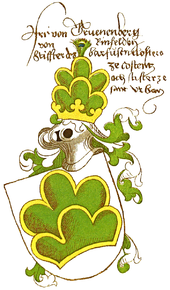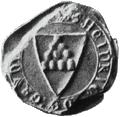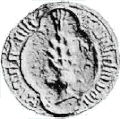Grünenberg (noble family)

The Barons von Grünenberg were a widely ramified aristocratic family , their representatives from the middle of the 12th to the middle of the 15th century in the Swiss plateau , especially in today's Bernese Oberaargau , as well as in Alsace and in southern Baden, especially in today's Markgräflerland and im Breisgau , appeared. Around one hundred people are known for this period of the late Middle Ages , who can be assigned to the family with great certainty.
history
Ancestors of the Barons von Grünenberg
In 1192 three brothers appeared as ministerials of the Church of Constance. Hugo von Grünenberg, mentioned for the first time in 1176, together with his brother Conrad transferred an estate in Bankholzen and an estate in Bohlingen to the cathedral chapter of Constance before March 25, 1192 . The two estates were jointure of her brother, the taverns Arnold II., For his wife. Hugo had previously been accepted into the Confraternity and given a benefice . He received a dwelling ( curia canonicalis ). The then Bishop Diethelm von Krenkingen left the two properties to Hugo von Grünenberg as a fief ( feodum claustralis ) through the hand of the Provost Ulrich . The father of the three brothers, Arnold I, was mentioned in 1162 as a ministerial of the Church of Constance. Since the second half of the 12th century, the four classic court offices of marshal, treasurer, chamberlain and tavern can be traced back to the court of the Bishop of Constance. These offices were predominantly occupied by the Hochstiftsministeriales . They were called "ministerialis ecclesiae Constantiensis". As a gift, Arnold II was one of the bearers of these four court offices. It is believed that he could have been the father of Heinrich I von Grünenberg, who appeared in Upper Aargau in 1224. The family was based in Grünenberg Castle , which later became Grünenberg Monastery in Bankholzen in the area of today's municipality of Moos (on Lake Constance) . The family also called itself "von Bankholzen".
The barons of Langenstein , of whom very little is known, probably belonged to the long-established nobility in the area of today's Bernese Oberaargau and the Lucerne hinterland. They appeared in 1194 when they founded the Cistercian monastery of Sankt Urban and furnished it with plenty of real estate from their property. A little later they died out. Presumably through an heir, most of the Langstein rule fell to the Barons of Grünenberg. A smaller part of the Langenstein's property ended up in the hands of the Knights of Luternau and the Barons of Balm through earlier dowries .
The Grünenberg in Upper Aargau
The barons of Grünenberg owned the noble rule of the same name from the 12th to the beginning of the 15th century as well as three individual castles in the three-part castle complex Langenstein , Schnabelburg and Grünenberg in the municipality of Melchnau (Canton Bern, Switzerland). The aristocratic rule consisted of land and judicial property, which included the villages of Melchnau, Gondiswil , Madiswil , Busswil , Leimiswil and Reisiswil .
In the 14th and 15th centuries, the Grünenberg from Lake Zurich to the Bernese Oberland as well as in the southern Baden region was followed by other possessions: Lords acquired through marriage (for example, the castle and village of Aarwangen ), fiefdoms (the Sanktgallische Meieramt in the village of Rohrbach , the Kyburg village Bleienbach ) as well as Habsburg and Kyburg pawn holdings, including the town of Huttwil , the inner office of Wolhusen (Entlebuch), castle and town of Rothenburg , the town of Wangen an der Aare . During the Burgdorf War , the Bernese took one of the castles on the Melchnau Schlossberg in 1383, according to tradition the Grünenberg, and "broke" it (that is, they put it in a state that was unable to be defended). According to the archaeological investigations in the 1990s, none of the three facilities was destroyed ("razed") at that time. However, the city of Bern enforced an opening right for Burg Grünenberg.
Representatives of the family also took part in the battle of Sempach as followers of the Habsburgs . The name Hans or Johans von Grünenberg appears among the fallen in the chronicles of the 15th century and in the battle chapel of Sempach. Its classification in the family is unclear.
The Grünenberg in southern Baden
- The Grünenberg as the owner of the moated castle and Binzen rule (near Lörrach)
- The Grünenberg as the upper school of the city of Breisach
The heirs and legal successors
The last male representative of the baron family, Wilhelm von Grünenberg, sold the Aarwangen castle and manor for 8,000 guilders to the city of Bern in 1432. In the course of the Old Zurich War , which Grünenberg fought on the side of Habsburg Austria and the city of Zurich, the city of Bern annexed Grünenberg Castle in 1444 and set up a small bailiwick there, which was merged with the neighboring and much larger bailiff of Aarwangen only a little later .
After Wilhelm's death, the remaining part of the reign passed through his daughters to various sons-in-law. In the course of only a few years, this inheritance, called the "Herrschaft Langenstein" in the sources, fell into the hands of the von Luternau family. In 1480 they had to sell Langenstein Castle and the remaining part of the former Gruenberg rule to the city of Bern. The three castles were left to decay and used as a quarry. At the site of Langenstein Castle, sandstone was also broken in the 19th century, so that the original castle courtyard has now been completely removed.
coat of arms

Blazon : In silver, a green, floating six mountain (1: 2: 3 mountains). The six mountains with some feathers appear as a crest, sometimes a kind of hat with the mountains in the upper part. The helmet covers are green on the outside and natural ermine on the inside.
In the Zurich coat of arms , the coat of arms appears divided into green and silver, with a floating golden "mountain of ten" (1: 2: 3: 4) on top. On the helmet a pointed hat with the divided shield image, on top with a bush of 12 black rooster feathers.
The Konstanz knight and citizen Conrad Grünenberg drew the coat of arms of the Barons von Grünenberg (to whom he was not related) in his coat of arms book from 1483 as a floating green six mountain with gold rims (3: 3 mountains). The coat of arms featured a cap from the same Sechsberg, crowned with a peacock feather, on a golden barons crown as a crest. The helmet covers are silver on the outside and green on the inside. In the text, the family comes from Rheinfelden and is referred to as the founder of the Barfüsser von Konstanz and the Cisterze from St. Urban.
The coat of arms also appears in Scheibler's coat of arms (there, however, also with the Sechsberg 3: 3), hinted at with additional golden (yellow) borders around the six green mountains that are also sometimes used elsewhere. In Scheibler's book of arms, the stinging helmet of the crest bears a golden baron crown.
The coat of arms in the seals
The barons of Grünenberg also led the Sechsberg in their numerous traditional seals, but sometimes also as a ten mountain with four rows of mountains (1: 2: 3: 4), with five rows and 15 mountains (1: 2: 3: 4: 5 ) or even with more mountains.
Margaretha von Kien (wife of Petermann I.): round seal, standing female figure with two coats of arms, right Sechsberg, left Kien
Further use of the coat of arms
The municipality of Melchnau , where the ancestral seat of the barons was once located, has the same coat of arms. The municipality of Eriswil has the coat of arms in different colors: the coat of arms is red. Eriswil belonged to the Grünenbergers as owners of the Rohrbach BE estate , where the Grünbergian Sechsberg is preserved in the base of the municipal coat of arms . The coat of arms itself is a gold star in red.
When the Bernese mayor Niklaus Friedrich von Mülinen (1760–1833) was raised to hereditary count by Emperor Franz I of Austria in 1816 , he took as a descendant of Johann III. von Grünenberg, called the Grimme, features the Grimme Sechsberg with a yellow border as one of the five helmet ornaments in his coat of arms.
state of research
August Plüss (1871-1910), a historian from Langenthal, chose the noble von Grünenberg family as the topic for his doctoral thesis, which appeared in 1900. With its in-depth evaluation of sources, it is still the standard work on the subject today. Plüss relied on the von Mülinen family's private library and a genealogy by Gottfried von Mülinen. His doctoral supervisor was the Bern history professor Wolfgang Friedrich von Mülinen (1863–1917). With his article Freie von Grünenberg and Langenstein from 1904 in the Genealogical Handbook on Swiss History , he submitted some supplementary and corrective information about the Grünenberg compared to his doctoral thesis.
The first scientific excavation took place on Grünenberg in 1949. In the process, the unique floor , still preserved in situ , made from St. Urban floor slabs in relief from the former castle chapel was found.
From 1992 to 1998 the castle ruins were subjected to a renovation , which was archaeologically accompanied. The Burgruine Grünenberg Foundation was responsible for the measures ; the work was carried out by the Archaeological Service of the Canton of Bern. During this time, the Langenthal historian Max Jufer (* 1922 in Lotzwil ) wrote a new version of the history of the noble family on behalf of the Grünenberg Burgruine Foundation, which was appropriately illustrated in 1994 for a wider audience.
people
- Heinrich II the Elder of Grünenberg (ext. 1224; died after April 13, 1286), baron and knight
- Markwart VII von Grünenberg (died October 18, 1376 in Fahr), baron and monk in Einsiedeln, mentioned as provost of the Fahr Frauenkloster from May 31, 1330 to January 21, 1356 , and from May 17, 1364 until his death Abbot of Einsiedeln monastery and imperial prince
- Margaretha II von Grünenberg (died between December 6, 1379 and 1380), baroness and nun in Säckingen, Coadjutrix until 1355, from then on until her death abbess of the Säckingen dynasty and imperial duchess, had managed the monastery with the highest praise
- Petermann I. von Grünenberg (adult from 1329; died 1375 or 1376), knight, lord of Aarwangen
- Wilhelm von Grünenberg (born before 1382; died on May 9, 1452), knight and diplomat in the entourage of the Dukes of Austria
Web links
- Franziska Hälg-Steffen: Grünenberg, from. In: Historical Lexicon of Switzerland .
- Anne-Marie Dubler : Grünenberg. In: Historical Lexicon of Switzerland . (Aristocratic rule)
- Private website about the Barons von Grünenberg
- Website of the association and the foundation Burgruine Grünenberg, Melchnau
Individual evidence
- ↑ Hans von Grünenberg ; was identified with Johann II the Grimmen von Grünenberg, who had died before February 3, 1384 (Plüss 1904: page 282, no. 28).
- ↑ a b Plüss 1900: p. 6.
- ^ Rudolf von Stillfried-Rattonitz , Count of Alcántara, and Adolf Matthias Hildebrandt (ed.): Des Conrad Grünenberg , Ritters and Burgers zu Constenz, Wappenbuch. Volbracht on the new day of the Abrellen do man zalt doing four hundred eighty and eighty jar . Rhenania Buchversand, Koblenz 2009, p. XCIIIIb (facsimile reprint of the original edition by CA Starke, Görlitz 1875–1884).
- ↑ Plüss 1904: p. 280.
- ↑ Jufer 1994: p. 132.
- ↑ Jufer 1994: p. 137.
- ↑ Jufer 1994: p. 161.
- ↑ Jufer 1994: p. 190.
- ↑ Plüss 1900: p. 6, note 1.
- ↑ "In the time before the First World War, two people from Oberaargau also worked on the State Archives [in Bern]: [...] the promising, unfortunately early deceased Dr. August Plüss (1871–1910), whose dissertation on the Barons von Grünenberg has remained the best monograph on a Bernese noble family. ”Quote from Karl H. Flatt from his article on State Archivist Gottlieb Kurz, 1866–1952 in the Oberaargaus yearbook, vol. 8, Langenthal 1965. p. 53. http://www.digibern.ch/jahrbuch_oberaargau/jahrbuch_1965/JBOAG_1965_053_058_gottlieb_kurz.pdf PDF 108.8 KB [2009].
- ↑ The results are published by the excavation manager René Wyss: Grünenberg , in: Ur-Schweiz , Volume XIII, No. 3, 1949. pp. 42–47.
- ↑ Website of the Archaeological Service of the Canton of Bern: Archive link ( Memento of the original of June 24, 2009 in the Internet Archive ) Info: The archive link was automatically inserted and not yet checked. Please check the original and archive link according to the instructions and then remove this notice. [23. April 2009].
literature
- Jakob Käser: Topographical, historical and statistical representation of the village and district of Melchnau in its relationship to the past, present and future . With two lithographic explanatory panels. Printed by J. Konrad, Langenthal 1855, Chapter XIII. The old Twing Lords' castles and news from the old Twing Lords , p. 183–194 ( online - see floor plan of the castles , p. 185).
- Wolfgang Friedrich von Mülinen : The Oberaargau . In: Contributions to local history of the Canton of Bern, German parts . Issue 5. Verlag von Nydegger & Baumgart, Bern 1890, article Grünenberg , p. 78-85 ( online ).
- August Plüss: The barons of Grünenberg in Kleinburgund . Inaugural dissertation to obtain a doctorate submitted to the high philosophical faculty of the University of Bern. In: Archives of the Historical Association of the Canton of Bern . Volume XVI, Issue 1.Stämpfli, Bern 1900, p. 43-291 , doi : 10.5169 / seals-370844 .
- August Plüss: Free from Grünenberg and Langenstein . In: Swiss Heraldic Society (ed.): Genealogical manual for Swiss history . Volume I: High nobility. Printed and published by Schulthess & Co., Zurich 1904, p. 278-289 ( online ).
- Max Jufer: The barons of Langenstein-Grünenberg . In: Yearbook of the Oberaargau . tape 37 . Merkur Druck AG, Langenthal 1994, p. 109-214 ( online ).
- Lukas Wenger: Ganerbensitz Grünenberg? - The ownership structure of the Barons von Grünenberg examined with the help of a genealogical database . In: Burgen und Schlösser, magazine of the German Burgenvereinigung e. V. No. 3/2007 . European Castle Institute, 2007, ISSN 0007-6201 , p. 152-155 ( online ).








